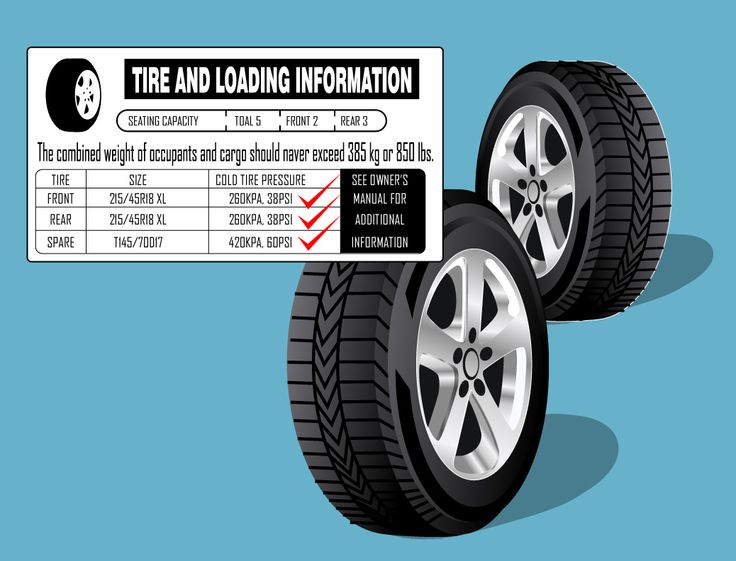From a safety and cost standpoint, tire maintenance is one of the most important things you can do for your car. The easiest way to care for your tires is both quick and inexpensive: maintain the correct tire pressure.
The recommended pressure for tires varies by the type of car and tire. Because maintaining your tires is so crucial to your safety and your car’s overall performance, it’s important to know what tire pressure is correct for your vehicle.
To learn what your tire pressure should be, look for your manufacturer’s recommendation, which is printed on a label inside your car. Depending on the vehicle, this label may be on the edge of the vehicle’s door, on the doorpost or in the glove box. The label will usually give recommendations for the front and rear tires as well as the spare, and it’s important that you stick to those guidelines. Even after you’ve replaced your tires, the same pressure guidelines on your car’s label apply to new tires of the same size.
Pressure recommendations are based on readings taken from a tire pressure gauge. Check the pressure first thing in the morning or wait at least three hours after driving; this provides sufficient time for them to cool back down.1
Driving on underinflated tires is one of the biggest causes of tire failure, according to the National Highway Traffic Safety Administration. And not having enough air in your tires can lead to other problems. Under-inflated tires wear out more rapidly, handle poorly and reduce fuel efficiency. On the other hand, overinflated tires are more susceptible to damage from road irregularities, and they also result in a bumpier ride. Overfilling your tires is just as dangerous as underfilling them, so it’s important you know what is recommended for your vehicle.
Knowing how to check tire pressure is critical to your safety and to keeping your tires in good working order.
When it comes to choosing a gauge, you typically have 3 options:
Put the pressure gauge into the valve stem, making sure the gauge is evenly and firmly pressed onto the stem. If you’re using a pen-style gauge, read the number on the rod that pops out of the sleeve. Read dial pressure gauges as you would a watch with one hand. With a digital pressure gauge, simply read the number on the screen. 2
Find your tires’ recommended PSI in the owner’s manual or on a sticker just inside the driver’s side door. The proper PSI is crucial to your safety and the car’s longevity. Underinflated tires can overheat and wear unevenly; overinflated tires can blow out.1
Underinflated tires can overheat and wear unevenly; overinflated tires can blow out.1
Temperature has a direct effect on your air tires’ air pressure, so for an accurate PSI reading, make sure to check tire pressure when tires are cold. If it’s cold outside, then you can assume your tires are losing PSI and you should check even more frequently. This will help to ensure maximum safety. Take your car to a mechanic you trust for a professional assessment.3
If you happen to find yourself without a tire gauge and your car doesn’t have an indicator for low tire pressure, there are several things you can do to figure out whether your tires need to be inflated.

Of course, knowing your recommended PSI isn’t enough. You have to ensure you’re checking your tires regularly. Experts recommend you check air pressure once a month.5 Your car’s tire pressure monitoring system TPMS measures the amount of air in your tires to let you know whether your tires are properly inflated.1
Frequently checking your PSI becomes even more important in the fall and winter, when outside temperatures drop and weather conditions fluctuate causing your tires to lose air more quickly. Generally, your tire will gain or lose 1 PSI for every 10-degree change in temperature, which means if you have a sudden drop of 30 degrees, you could lose 3 PSI overnight.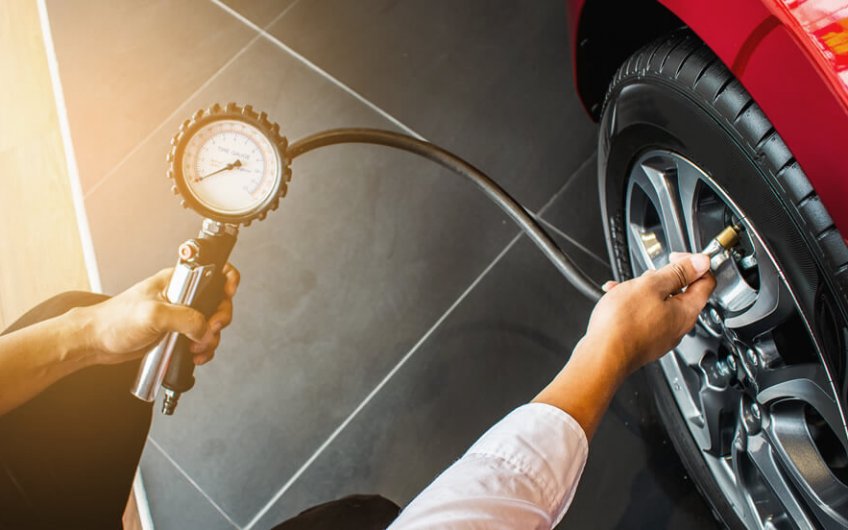 If your tires were already low, this could cause tire damage, steering problems or even a flat tire.3
If your tires were already low, this could cause tire damage, steering problems or even a flat tire.3
Knowing and maintaining the right air pressure is important to the safety and longevity of your tires. All it takes is a tire pressure gauge and a few minutes of your time.
Once you have the right tire pressure, make sure you also have the right coverage. Learn more about how Nationwide auto insurance can help protect you and save you money.
Sources:
1 https://www.pirelli.com/tires/en-us/car/driving-and-tire-tips/how-to-read/recommended-tire-pressure, Accessed April 2022.
2 https://www.consumerreports.org/cro/tire-pressure-gauges/buying-guide/index.htm#:~:text=There%20are%20three%20types%20of,of%205%20to%2099%20psi., Accessed April 2022.
3 https://www.firestonecompleteautocare.com/blog/tires/should-i-inflate-tires-cold-weather/, Accessed April 2022.
4 https://rxmechanic.com/how-to-check-tire-pressure-without-gauge/, Accessed February 2022.
When it comes to driving safety, tire pressure is always one of the hottest topics. Why does tire pressure matter? What the heck is that little annoying symbol on my dashboard? Should I under-inflate my tire during the winter? How often should I check my tire pressure?
We got tons of questions like this from our community, so for today, let's dive deep into the world of tire pressure, put our geeky glasses on and figure out everything you need to know about your tires.
1. What's The Recommended Tire Pressure For My Car?
The recommended tire pressure varies based on the vehicle makes determined by the manufacturer after thousands of tests and calculations. For most vehicles, you can find the ideal tire pressure on the sticker/card inside the driver’s door for newer cars. If there’s no sticker, you can usually find the info in the owner’s manual. Normal tire pressure is usually between 32~40 psi(pounds per square inch) when they are cold. So make sure you check your tire pressure after a long stay and usually, you can do it in the early morning.
So make sure you check your tire pressure after a long stay and usually, you can do it in the early morning.
2. How To Check The Tire Pressure?
After knowing the proper tire pressure of your vehicle recommended by the manufacturer, you should check your tire pressure regularly to make sure that you are in good shape.
You can check your tire pressure in auto part stores, the mechanics, gas stations, and at home. To check tire pressure at home, you need:
As tire pressure changes with the temperature a lot, and recommended tire pressures are cold inflation pressure, you should start with cold tires if possible. We mostly check the tire pressure after one night's rest to avoid the heat from the friction of the last drive, and before the temperature goes up.
Unscrew the valve cap and press the tire gauge onto the valve stem hard enough until the hissing sound disappears. There should be a reading as long as the gauge is well connected to the tire.
There should be a reading as long as the gauge is well connected to the tire.
You can then note down the tire pressure of each tire, and compare them with the ideal psi you read from inside your driver’s door or in the owner’s manual. Make sure you read in detail, as for some vehicles, front and rear tires have different recommended psi.
If you find a tire underinflated, use the air compressor to fill your tires. You can either buy an air compressor in the auto parts store or use one in a gas station. Remember to rest your tires for at least half an hour to make sure they’re cold and the reading is accurate. If you have to fill your tires when the tires are hot, inflate them 3~4 psi above the recommended psi, and check again with your gauge when they are cold. It’s ok to overinflate a bit when filling the tires, as you can let the air out with the gauge.
After filling the tires, use your tire pressure gauge to check the tire pressure again and make sure they are in a good range.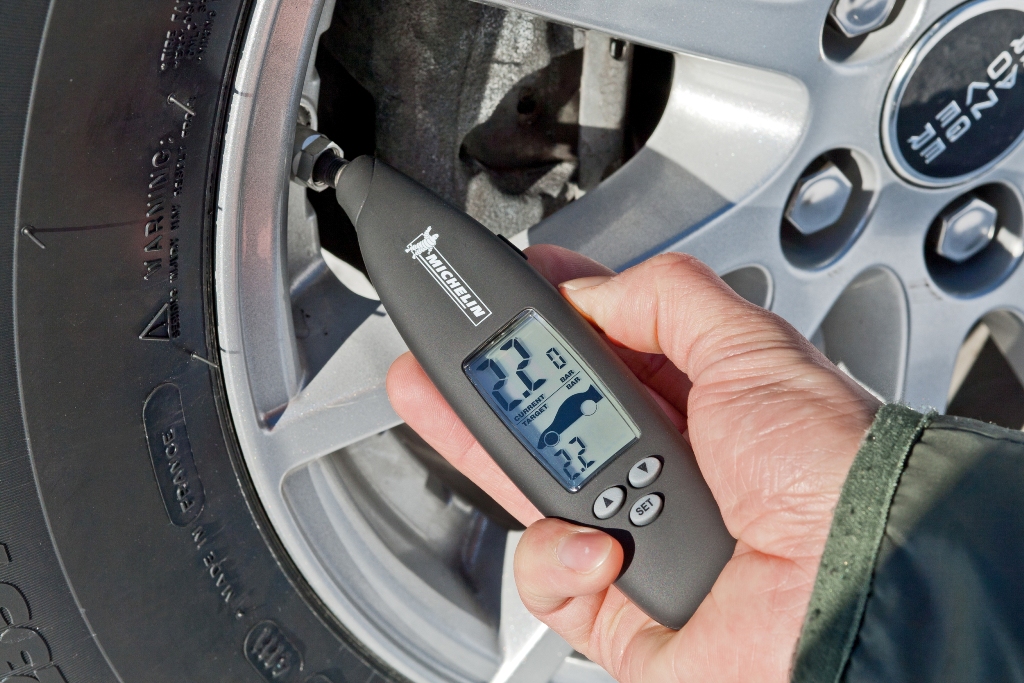 Let the air out a bit if they are over-inflated by pressing the gauge harder on the valve stem.
Let the air out a bit if they are over-inflated by pressing the gauge harder on the valve stem.
3. How To Maintain Proper Tire Inflation?
Tire maintenance is essential for the overall performance of your vehicle, and we highly recommend that you check your tire pressure every time you inflate your tire, each 10°F (5.6 °C) temperature change, and every 30 days.
Be mindful that don’t wait until the TPMS(Tire Pressure Monitoring System) light come on before you check the tire pressure, as the normal TPMS may:
For more information about the tire pressure monitoring system, please check our post about TPMS: What is TPMS and Why Does it Matter?
Thus, we highly recommend that you check your tire pressure regularly, especially before a long drive or heavy load driving.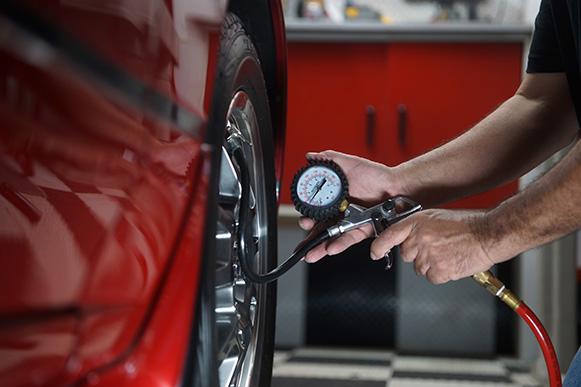 Also, temperature affects the tire pressure a lot, and we will explain it in the next section.
Also, temperature affects the tire pressure a lot, and we will explain it in the next section.
4. How Does Temperature Affect Tire Pressure?
First of all, the rule of thumb is for each 10°F (5.6 °C) decrease in temperature, the tire pressure will drop by one psi for most passenger vehicles. When it comes to commercial truck tires, which are often inflated to over 80 psi (twice as much as a passenger vehicle tires), the change of tire pressure according to temperature is doubled to 2 psi for every 10°F.
For the non-nerdy readers, just remember this rule of thumb and keep in mind that you will need to monitor your tire pressure during different seasons or a sudden temperature change. For those who want a deeper dive into how psi's are determined, here's the science behind it.
The equation we use to calculate the relationship between tire pressure and the temperature is called the Ideal Gas Law. It is a good approximation of the behavior of many gases under many conditions.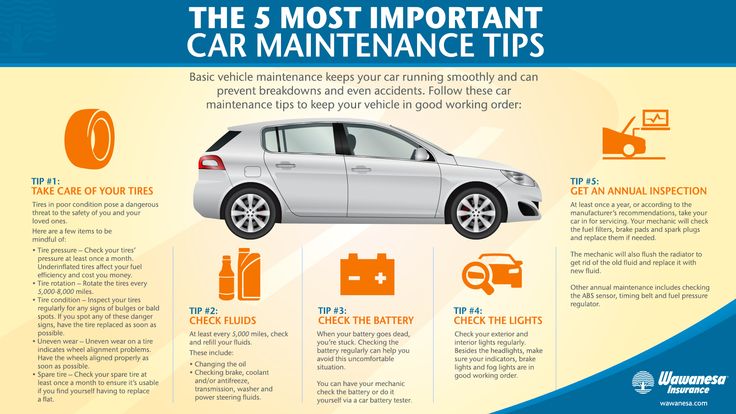 (Appx1) It works well for most low-pressure gases. When applied to tire pressure calculation, the error is less than 1%.
(Appx1) It works well for most low-pressure gases. When applied to tire pressure calculation, the error is less than 1%.
First, we take the Ideal Gas Law equation and apply it to our circumstance:
where,
P = absolute pressure
V = gas volume in the tire
n = the number of molecules of gas in the tire
R = universal gas constant
T = temperature
Since we are trying to examine the pressure change according to the temperature, let's assume two tire pressures P1 & P2 at their set temperatures T1 & T2.
Given the n and R are both constants, and the gas volume in the tire is also a constant, we can take those constants out of the equation, and suddenly we get this straightforward one:
Let's say the temperature drops from 100°F to 50°F, the tire pressure at 100°F is 35 psi, so what's the tire pressure now at 50°F?
(the metric system is getting in the way, huh?)
Absolute Pressure = tire pressure + sea level air pressure (14. 7 psi). So,
7 psi). So,
Put all that into the equation,
So a 50°F drop in temperature lowers the air pressure by 4.5 psi, which is pretty much the same according to our rule of thumb.
5. How Does Tire Pressure Affect Driving
Both overinflation and underinflation affect your tire performance a lot, and serious problems might occur. According to NHTSA(National Highway Traffic Safety Administration), driving on underinflated tires increases a driver's chance of being in a serious accident by 300%. So how will a bad tire pressure affect driving safety? We will explain in detail below.
How tire pressure affects gripThe grip is mostly associated with the size of the contact patch between the tire and the road. An over-inflated tire radically decreases the contact patch while an under-inflated tire does the opposite.
A larger contact patch gives you more grip, and this is the exact reason why lots of racers will intentionally decrease their tire pressures to create a larger contact patch on a dry race track.
However, despite the fact that an under-inflated tire will cause more fuel consumption and improper tear and wear of the tires, for most daily commuters, it might cause an even scarier problem, which is hydroplaning.
Hydroplaning is a hazardous event when a layer of water builds between the wheels and the road surface, leading to a loss of traction that prevents the vehicle from responding to control inputs. (Appx2)
Hydroplaning occurs when the pressure of the tire pushing on the ground is equal to the water pushing back up on that tire. The size of the contact patch, given the force or the weight of the tire, is the same, directly affects the average pressure the tire's putting down on the road. The larger the contact patch (by deflating the tires), the less pressure it puts on that same area. So there's a causal relationship between your tire pressure and the possibility of a hydroplaning event.
Here's a more visual explanation of what is happening between a properly-inflated tire and an underinflated tire when driving on a wet road.
To avoid a hydroplaning event, ALWAYS inflate your tires properly. Also, check your tires' treads, which make the water flow around the tires more efficiently, and of course, driving slow is always a big plus.
How tire pressure affects tire wearThe contact patch directly decides the pattern of the tire's wear and tear. You don't want your tires to wear out prematurely just because you have an over or under-inflated tire.
How tire pressure affects fuel economyImagine you are a ball rolling on the ice, there's no friction between the two surfaces, how much extra force do you need to apply to keep the ball moving? Zero (Thanks, Newton). The same applies to your fuel consumption when it comes to driving on the road. The rolling resistance between your tires and the road significantly affects fuel economy, and by now we should all know the logic behind this, lower tire pressure leads to a larger contact patch, which causes higher rolling resistance, and thus, poor fuel economy.
A Michelin study showed that your tire is accountable for at least 1/5 of your total fuel consumption and a 1-bar of pressure drop (14.5 psi) would increase your fuel consumption by 3-5%.
6. Special Conditions For Tire Pressure Manipulation
There are of course circumstances where you want to manipulate your tire pressure to meet specific requirements. Like the aforementioned track race, or if you are driving on sand, mud, etc. However, as a daily commuter, we strongly suggest you regularly check your tire pressure, preferably once a week and anytime you might take a long road trip, and always keep the tires properly inflated!
Conclusion
Tire pressure is always a hot topic regarding driving safety, and it's important to keep an eye on the tire pressure to maximize fuel efficiency and safety.
Before you go
We'd like to offer you our most popular ZUS Smart Vehicle Health Monitor for FREE to better take care of your car and save $$$ on car expenses. Claim your free unit here.
Claim your free unit here.
Top Posts from nonda:
What is a Car Diagnostic Test & How to DIY?
What Does Check Engine Light Mean & How to Fix it?
Best OBD2 Scanner & Code Reader: Complete Buying Guide
OBD2 Codes: What You Need to Know
Appendix 1 - Ideal gas law - Wikipedia.
Appendix 2 - Aquaplaning - Wikipedia.
Alina Deeva
8 years cannot buy a compressor
Author profile
Tire pressure is most often looked at when there are obvious problems and the car cannot be driven.
Nevertheless, everything is much more complicated: how the car will behave on the road depends on the pressure, how often the suspension will have to be repaired, the rims corrected and the tires changed. The more attentive the driver is to tire pressure, the less he spends on car maintenance.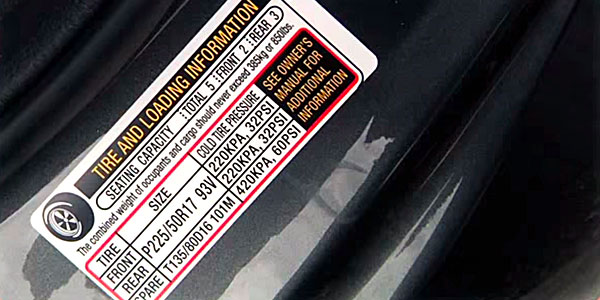 nine0003
nine0003
Tire pressure can be normal, under or over.
At normal pressure , the tire is in contact with the road surface evenly throughout the entire tread pattern. When turning, the contact patch may change, but on a flat surface when moving straight, it does not change. Contact patch - the bearing surface of the wheel, the part of the tire that comes into contact with the road surface. nine0003
When the tire pressure is low, the contact patch is shifted to its sidewalls. The wheel rests on the side surfaces, while the central part collapses. Here are the main consequences of insufficient tire pressure:
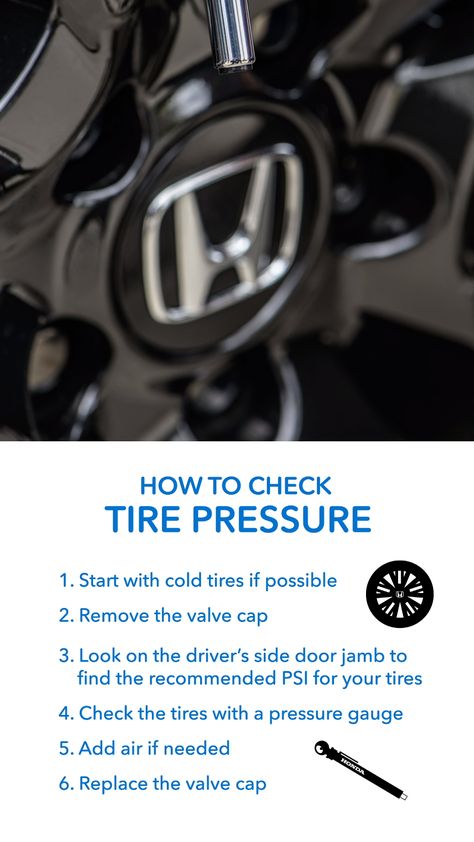
With overpressure , the contact patch moves to the center of the tire, the side surfaces of the wheel do not come into contact with the coating. This also causes premature tire wear. That's why it's bad:
/guide/rezina/
How to choose tires for a car or crossover
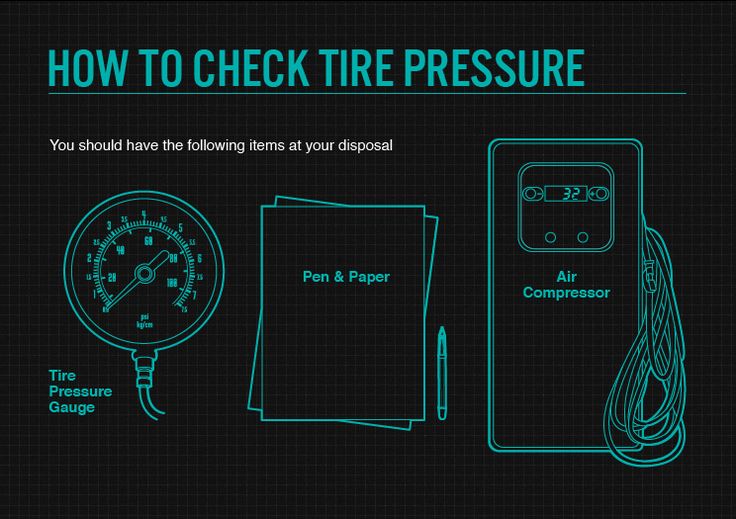
Different tire pressures is another variation from the norm. In this case, all four tires will wear out differently. In addition to the consequences already listed, the car can drift to the side of the wheels with the least pressure. According to the recommendations of manufacturers and specialists, the pressure should be the same in tires for wheels of the same axle. nine0003
Normal pressure in passenger car tires is in the range of 1.9-2.5 bar. But each manufacturer has its own standards. On the Internet, it is quite easy to find summary tables with such standards for almost all makes and models of cars. But it is difficult to understand when the information is reliable: on the official websites of automakers or tire manufacturers, this data is usually not available, and where third-party sites got it from is unknown.
In addition to tables with manufacturer's standards, there are also average normal values for wheels of different sizes. But it is better to adhere to official recommendations, especially since they can almost always be found on the car itself.
/guide/shina-s-probegom/
How to buy used tires for a passenger car
If you have a car manual, you can search for tire pressure standards in it. There is also information on the car itself. Here's where she might be:
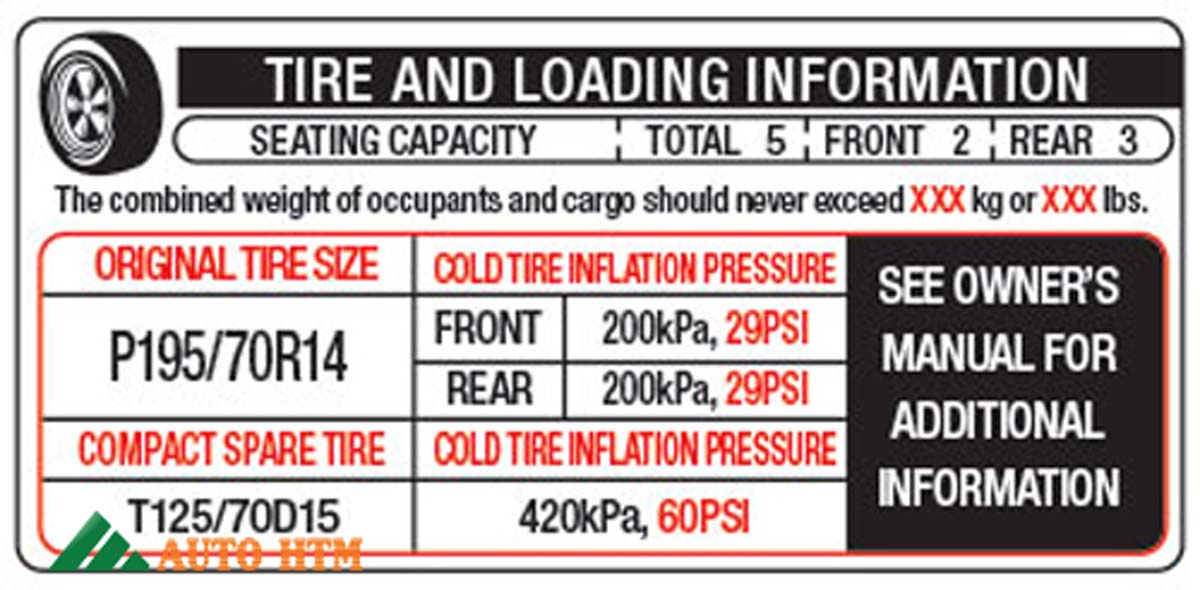 The norm for an empty car is 1.9bar on the front and rear axles, for equipped - 2.1 bar on the front axle and 2.3 bar on the rear. And this is a sticker in the glove compartment of the Chevrolet Aveo 1.2. The manufacturer indicates the same tire pressure on the front and rear axles - 2.1 bar for an empty car and 2.3 bar for an equipped
The norm for an empty car is 1.9bar on the front and rear axles, for equipped - 2.1 bar on the front axle and 2.3 bar on the rear. And this is a sticker in the glove compartment of the Chevrolet Aveo 1.2. The manufacturer indicates the same tire pressure on the front and rear axles - 2.1 bar for an empty car and 2.3 bar for an equipped Another way to find out what pressure should be in your car's tires is to use various pressure calculation calculators. It is enough to select the make, model and year of manufacture of the car to get the recommended axle pressure. Some services provide a choice of season and weight - the standards will vary. nine0003
The pressure value is also applied to the tire itself. Usually it is specified separately from the dimensions in psi - pounds per square inch. But this indicator cannot be used as a normative one: it indicates the maximum allowable pressure that a tire can withstand. If you inflate the wheels to this pressure, they will most likely burst.
When using a car regularly, it is important to measure tire pressure at least once or twice a month, and preferably once a week. Be sure to do this before a long trip, after a long stop and with a sharp change in temperature. After changing seasonal tires, it will be useful to check the pressure after about 100 km of run.
You can measure tire pressure yourself or at any tire shop: most likely, they won’t even take money from you. nine0003
To measure the pressure yourself, you will need a pressure gauge. Here's what they are:
Here's what they are:
Most often, the pressure scale on pressure gauges is made in bars, in Russia this particular unit of measurement is used. Sometimes a double scale is found on dial gauges, pressure is added in psi. 1 bar is 14.5 psi.
You can find similar tables for converting one value to another and use them. Here are generally all options for units of measurement and indications up to 4.0 bar. Source: pokrishka.ru Another way to convert the pressure value from one unit to another is to use any online converter.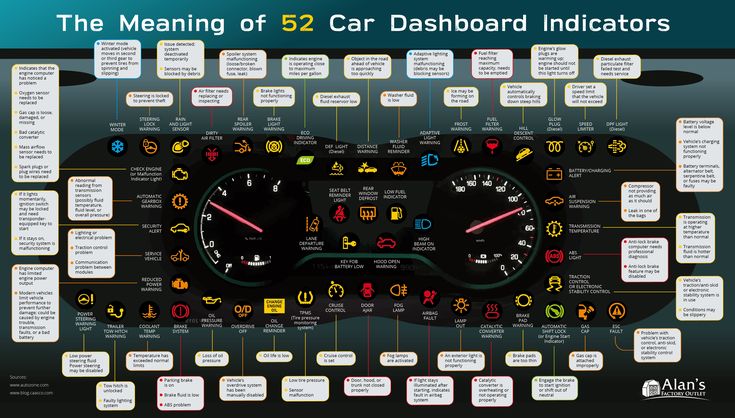 Source: google.com
Source: google.com If you haven't bought your own pressure gauge yet, you can measure tire pressure at a gas station. Large gas stations, as a rule, are equipped with special points for tire inflation, where there are also pressure gauges. And there is also a pressure gauge on almost any compressor.
Modern cars have a tire pressure monitoring system. When it falls below the recommended rate, a corresponding icon appears on the on-board computer. This system is called the Tire Pressure Monitor System, TPMS.
If such a system is not available from the factory, you can purchase a similar one. It operates by analogy with the factory one: sensors are installed on the rims, and a control unit is installed in the passenger compartment, to which pressure and temperature readings from each of the wheels are constantly transmitted. There are many options for different brands and models of cars, and the cost starts from about 2000 R. Often, sensors in such systems are installed instead of a nipple cap. They are larger, stick out a lot, so they are easy to damage when driving on bad roads or deep snow. nine0003
They are larger, stick out a lot, so they are easy to damage when driving on bad roads or deep snow. nine0003
/wtf/bezkoles/
How online tire shops cheat car owners
Here's how tire pressure monitoring systems work.
According to ABS sensors. Analyzing the rotation speed of each of the wheels, the control unit will quickly realize that one of them has begun to rotate at a different speed, an indication will appear on the instrument panel. At the same time, there will be a pressure reset button in the cabin or in the on-board computer menu. It must be pressed after adjusting the pressure so that the control unit remembers the new readings. nine0003
According to the sensors in each of the wheels. The sensors are installed inside the tire under the rim nipple. The antenna captures their readings and displays them on the on-board computer screen, the data can be monitored in real time: in the morning, after overnight parking or when driving on the highway in hot weather.
Different car manufacturers have different sensors. For example, Volkswagen and Mercedes have no difference on which wheel which sensor is on: the system itself will determine and show the pressure correctly. But on Hyundai or Subaru, the sensors are located exactly where you need them: if you swap them, the readings will be displayed incorrectly, and the wheels on the on-board computer screen will be confused. nine0003
/list/lampochki-na-paneli-priborov/
How to correctly read the signs on the dashboard
A yellow exclamation mark in a tire cut across is the “Check tire pressure” sign. Photo: Smile Fight / Shutterstock Standard dial gauge. It usually has two scales and a reset button. Source: market.yandex.ru Mechanical pressure gauges are like a pen. These are hollow tubes with a drop-down scale. They are stronger than turnouts, but may be less accurate. Source: market.yandex.ru Electronic pressure gauge is the most modern and accurate.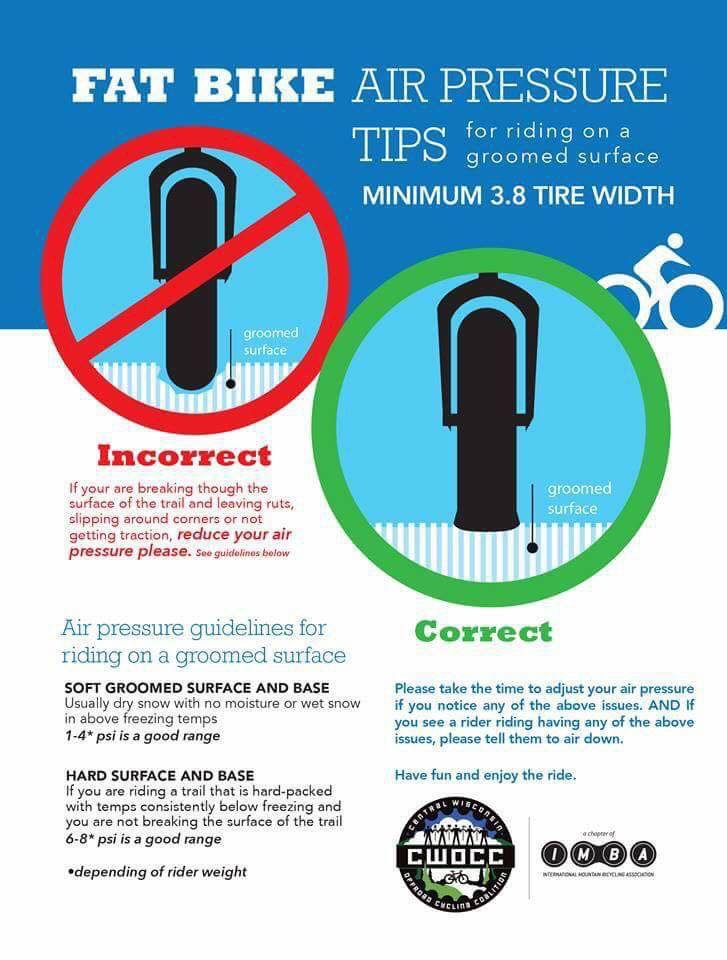 In addition to fixing readings and a reset button, it usually has a backlight. It is much more convenient to measure tire pressure in the dark in this way. Source: market.yandex.ru
In addition to fixing readings and a reset button, it usually has a backlight. It is much more convenient to measure tire pressure in the dark in this way. Source: market.yandex.ru To measure tire pressure, you need to unscrew the cap on the nipple, reset the pressure gauge and install it on the valve. The readings obtained are compared with the recommended norms and, if necessary, the pressure is adjusted. It is important to measure the pressure on each wheel, and the tires must be "cold": the car needs to stand for at least a few hours.
If the pressure is below normal, the wheel must be pumped up with a compressor from the cigarette lighter, a foot pump or a stationary compressor at a gas station or tire shop. Almost each of these devices also has a pressure gauge, so you don’t have to use a separate one. nine0003
/list/mashina-vsegda-gotova/
6 habits that will help you avoid ridiculous car troubles
High blood pressure is not a problem either.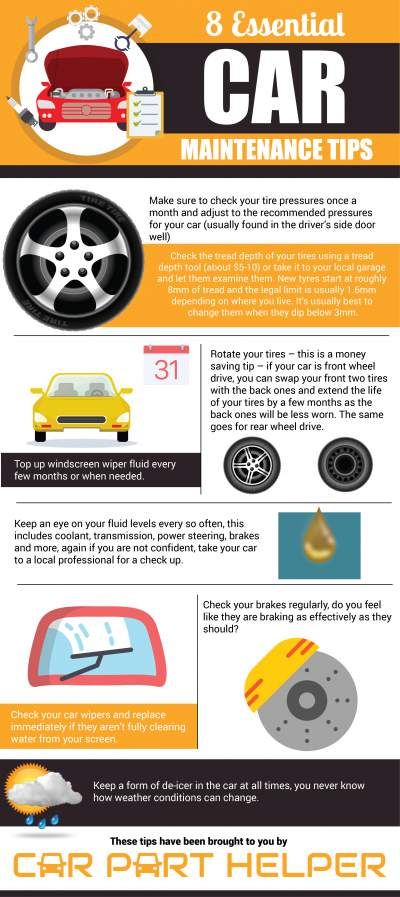 It is enough to press on the spool in the nipple and bleed off excess air.
It is enough to press on the spool in the nipple and bleed off excess air.
At the very end of the procedures, it is important to screw the cap on each nipple.
Almost every major gas station has a similar tire inflation machineThe tire pressure of a car does not always have to be the same. Its normal value may change under the influence of various factors. nine0003
Season. In summer, due to the high temperature, the air in the tires expands, the pressure becomes higher. And if you move on hot asphalt, then the indicator will increase even more. Therefore, in summer it is especially important not to pump the wheels and check the pressure on well-cooled tires.
In winter, when the temperature drops, the pressure level in the tires, on the contrary, drops. Not critical, but it is worth considering when pumping up the wheels. In this case, the pressure should be measured only after the car has stood still in the open air for at least a couple of hours.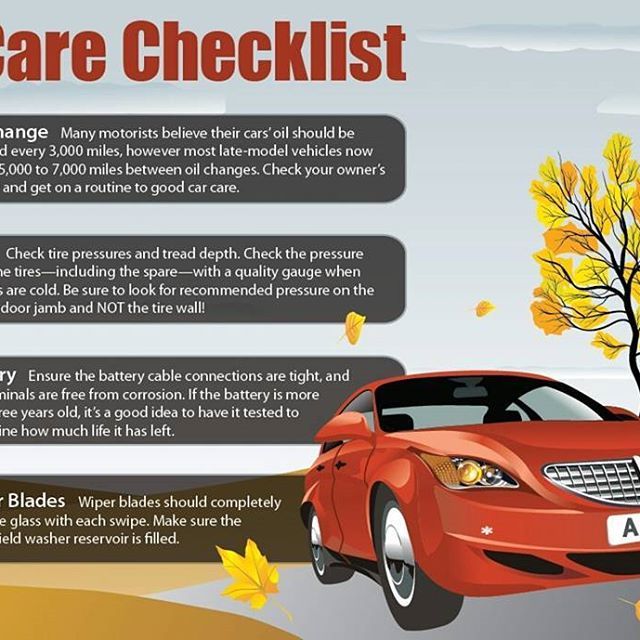 In winter, it makes sense to pump over the wheels by 0.2 bar. nine0003
In winter, it makes sense to pump over the wheels by 0.2 bar. nine0003
Car loading. The pressure standards for different car loads are usually already indicated by the manufacturer on the same stickers. The principle is simple: when the load increases, you need to increase the pressure at the wheels on the rear axle.
/guide/pricep/
How to drive a car with a trailer
As an example, using the online calculator: for the Volkswagen Polo 1.2 TSI, the recommended tire pressure without load in summer is 1.9 bar on both axles. Source: ka4nikoleso.info And now the same car, but instead of summer they chose winter, the recommendations have changed. The tire pressure rate on the front axle has become 2.0 bar, and on the rear axle - 2.2 bar. If you experiment with load switches, you can see that for a loaded machine, the recommended rates also increase Coating condition. On off-road, especially on loose earth or sand, you need to bleed the pressure in the tires, even below 1.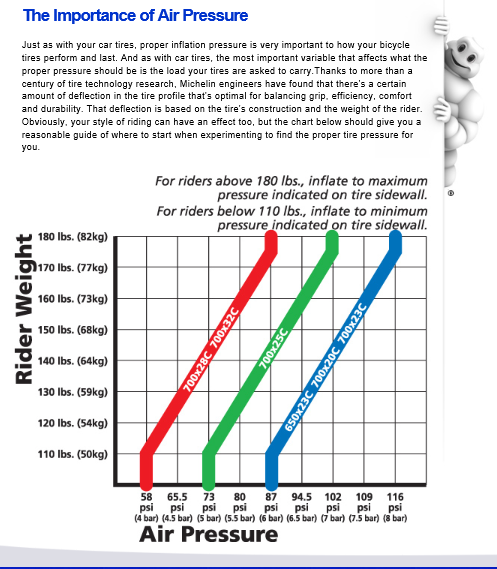 0 bar. The area of adhesion to the surface will increase, and the car will become more passable. In loose, rough snow, this technique should also help. The main thing is to perform all maneuvers at low speed, without sudden movements. Otherwise, there is a risk of disassembling the wheel.
0 bar. The area of adhesion to the surface will increase, and the car will become more passable. In loose, rough snow, this technique should also help. The main thing is to perform all maneuvers at low speed, without sudden movements. Otherwise, there is a risk of disassembling the wheel.
Speed and driving style. High speed, sharp turns, starts and stops heat up the tires more than during normal driving. This means that the pressure in them increases. That is, you should not pump over the wheels if you cannot change the driving style to a more relaxed one. This advice is also relevant for trips to the mountains. Long braking on descents, steep climbs and sharp turns affect tire pressure more than pressure reduction at altitude. nine0003
The standard recommended pressures will not work with custom size low profile tyres. You can focus on summary tables with pressure depending on tire sizes - they take into account different profile heights. You can choose the right pressure empirically. But it is best to seek the advice of specialists. Low profile tires are much more sensitive to incorrect pressure than standard tires.
But it is best to seek the advice of specialists. Low profile tires are much more sensitive to incorrect pressure than standard tires.
/best-auto-2022/
Top 10 car articles of 2022
And one more important point: when monitoring tire pressure, it is important to remember about the spare wheel. For a full-size spare tire, the normal pressure will be the same as in the rest of the tires. But for rolling, a higher pressure is recommended - at the level of 4.2-4.5 bar. Roll-out - a spare wheel with a tire width less than the standard one, so the general pressure standards will not work. You need such a spare wheel to get to the nearest service, you can’t constantly ride it.
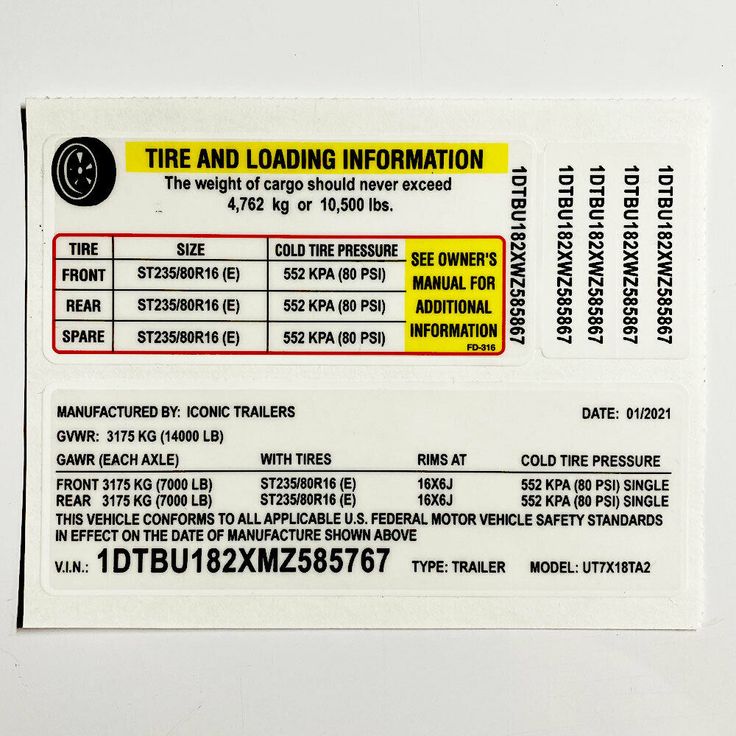
News that concerns everyone is in our telegram channel. Subscribe to keep abreast of what is happening: @tinkoffjournal.
The question that infuriated the experienced: what is the actual pressure in a car tire
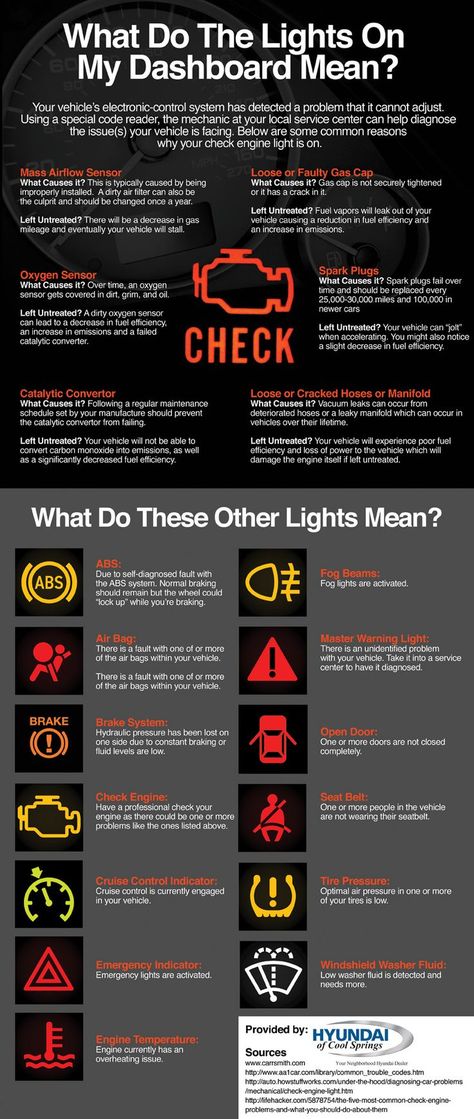 What pressure should be in the tires of a passenger car?
What pressure should be in the tires of a passenger car? 1
What pressure should be in the tires of a passenger car?
It is indicated on a special plate, which is usually located on the inside of the gas tank hatch or inside the doorway. Here the excess pressure in the tire is indicated - it is shown by the indicator of the pressure gauge or the pump itself. The average overpressure is 2 bar. Trucks have much higher pressure.
Recommended for this machine is 2.2 bar front and 2.1 bar rear. When fully loaded, the pressure in the rear wheels must be increased by another 0.6 bar
Photo: Leonid Menshenin / 74.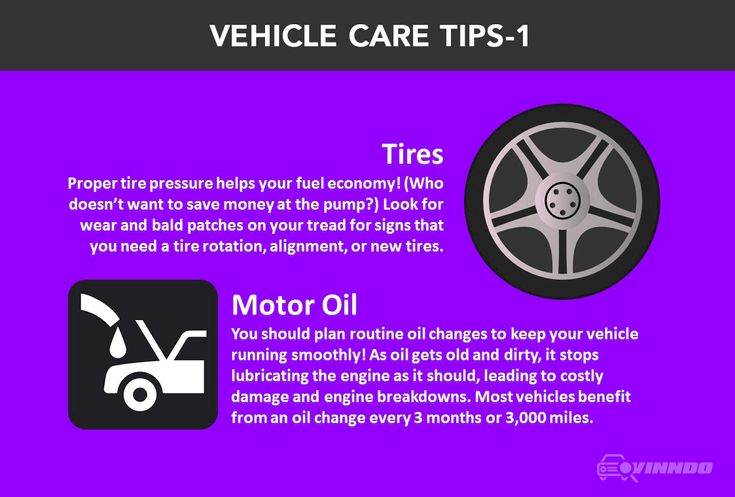 RU
RU
The pressure is indicated for a cold tire, that is, a few hours after the car stops - the wheel heats up while driving, and the pressure rises slightly.
Pressure may vary depending on usage, for example, when loading the vehicle or driving at high speed, the manual may recommend increasing the pressure.
Share
2
In what units is pressure measured and why are they different everywhere? nine0003
Pressure is a flirtatious quantity and uses a lot of quantities for its measurement. The most official of them - pascal - is rarely used in everyday life due to its smallness. For example, atmospheric pressure is close to 100,000 pascals.
Therefore, in practice, techies use three units of measurement that are close to just atmospheric pressure. These are physical atmosphere (1 atm), technical atmosphere (1 atm or kg/cm2) and bar. The last one is the most popular. All three units differ, but very slightly - within 2%.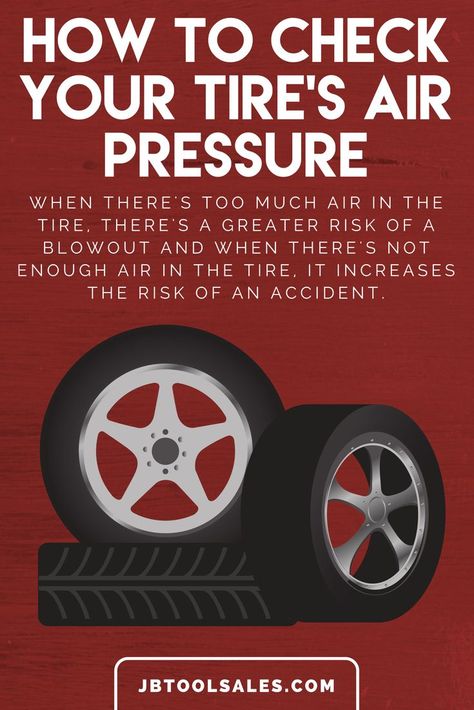 For practical purposes, 1 bar can be taken equal to 1 atm or 1 atm (kg/cm2). nine0003
For practical purposes, 1 bar can be taken equal to 1 atm or 1 atm (kg/cm2). nine0003
The pressure gauge of this old-fashioned pump shows the pressure in megapascals, which is not very convenient
Photo: Leonid Menshenin / 74.RU
However, there are devices calibrated, for example, in megapascals: 0.1 MPa (100 kPa) is equal to 1 bar .
Share
3
What happens if you don't monitor your blood pressure?
Under-inflated tires increase fuel consumption, tire wear and the risk of punctures. Pressure below 1 bar threatens with disassembly. nine0235
An overinflated wheel overloads the cord and makes the machine subjectively stiffer. Occasionally, we come across cars with excessive tire pressure (3 bar) for a test - it is set when transporting a car on a car transporter. When driving over rails or medium potholes, such wheels can perform a good uppercut. The risk of getting a hernia or breaking a wheel also increases.
The risk of getting a hernia or breaking a wheel also increases.
The pressure in the front and rear tires may differ, even if they are of the same brand: the load on the axles of the vehicle is uneven. But a strong difference in pressure between the tires of the same axle is detrimental to handling and can play a cruel joke in the event of emergency braking. So watch not only for pressure, but also for its uniformity. nine0235
Share
4
Why flat tires are sometimes useful
Not only because some people don't know how to park and warm up cars in the yards. Reducing pressure increases the contact area and grip properties of the tire, which can be useful in force majeure circumstances. For example, you are trying to drive up an icy hill with bad tires. The main thing is not to overdo it: a regular tire at a pressure of around 1 bar can come off the wheel. There are cars with low pressure tires, but this is a very unusual technique like this Burlak.